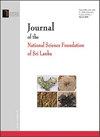通过数学模型分析隔离、隔离和疫苗接种对新冠肺炎传播的影响
IF 0.4
4区 综合性期刊
Q4 MULTIDISCIPLINARY SCIENCES
Journal of the National Science Foundation of Sri Lanka
Pub Date : 2023-04-10
DOI:10.4038/jnsfsr.v51i1.10698
引用次数: 1
摘要
目前实施的主要新冠肺炎控制策略是保持社交距离、隔离疑似接触者和隔离感染者。本文提出了一个考虑这三种控制策略的确定性分区数学模型。基于所提出的模型,讨论了疫苗接种对疾病抑制的影响。基于所提出的数学模型,确定了与疾病抑制相关的临界疫苗接种率和接种人群规模。传染病建模中最常用的关键术语繁殖数量的不同形式与所提出的模型相关。对繁殖数量进行敏感性分析,以确定主要影响疾病传播的模型参数。基于模型疾病控制参数区域的再现次数,确定了这些参数区域,并给出了这些参数的图形表示。根据所提出的数学模型的结果,可以观察到尽早实施疫苗接种过程有助于更好地控制疾病。然而,为新冠肺炎等新的门诊疾病研制成功的疫苗需要相当长的时间。因此,启动新冠肺炎疫苗接种程序需要相当长的时间。据观察,在以特定速度开始疫苗接种过程后,应继续进行,直到接种人群达到临界规模。©2023,美国国家科学基金会。保留所有权利。本文章由计算机程序翻译,如有差异,请以英文原文为准。
Analyzing the effects of quarantine, isolation, and vaccination on the spread of COVID-19 via a mathematical model
The main COVID-19 control strategies presently practiced are maintaining social distancing, quarantin-ing suspected exposures, and isolating infectious people. In this paper, a deterministic compartmental mathematical model is proposed considering these three control strategies. Based on the proposed model the effect of vaccination on the suppression of the disease is discussed. Critical vaccination rate and vaccinated population size relevant to disease suppression are determined based on the proposed mathematical model. Different forms of the most used key term in infectious disease modelling, reproduction number, are determined relevant to the proposed model. Sensitivity analysis of the reproduction numbers is done to identify model parameters mostly affecting the spread of the disease. Based on the reproduction number of the model disease controlling parameter regions are determined and graphical representations of those parameter regions are presented. Based on the results of the proposed mathematical model, it is observed that earlier implementation of the vaccination process is helpful to better control the disease. However, it takes considerable time to invent successful vaccinations for newly out-breaking diseases like COVID-19. Therefore, it took considerable time to start the vaccination process for COVID-19. It is observed that after starting a vaccination process at a particular rate it should continue until the vaccinated population reaches a critical size. © 2023, National Science Foundation. All rights reserved.
求助全文
通过发布文献求助,成功后即可免费获取论文全文。
去求助
来源期刊

Journal of the National Science Foundation of Sri Lanka
MULTIDISCIPLINARY SCIENCES-
CiteScore
0.90
自引率
0.00%
发文量
57
审稿时长
>12 weeks
期刊介绍:
The Journal of National Science Foundation of Sri Lanka (JNSF) publishes the results of research in Science and Technology. The journal is released four times a year, in March, June, September and December. This journal contains Research Articles, Reviews, Research Communications and Correspondences.
Manuscripts submitted to the journal are accepted on the understanding that they will be reviewed prior to acceptance and that they have not been submitted for publication elsewhere.
 求助内容:
求助内容: 应助结果提醒方式:
应助结果提醒方式:


